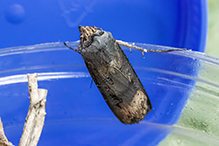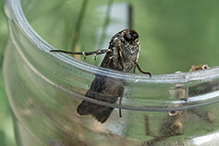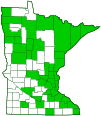ipsilon dart
(Agrotis ipsilon)
Conservation • Description • Habitat • Ecology • Distribution • Taxonomy
|
||||||||
| Hodges # | 10663 |
|||||||
Conservation Status |
||||||||
| IUCN Red List | not listed |
|||||||
| NatureServe | N5 - Secure SNR - Unranked |
|||||||
| Minnesota | not listed |
|||||||
Description |
||
Ipsilon dart, also known as black cutworm, is a very common, very widespread, migratory, medium-sized moth. It occurs worldwide on every continent except Antarctica, but it is absent from the far north and from most tropical regions. In the Northern Hemisphere, where it is most common, it migrates north in the spring and south in the fall. Adults are present in Minnesota from June to October in fields, gardens, lawns, and croplands. The larvae, called cutworms, are serious pests of agricultural crops, including most vegetable crops, alfalfa, beans, clover, corn, cotton, potatoes, sugar beets, strawberry, sunflower, tobacco, and tomatoes. Adults are ⅞″ (22 mm) in length and have a 1½″ to 1⅞″ (38 to 48 mm) wingspan. Moth size is often given in terms of forewing length, which in this case is ⅝″ to 13⁄16″ (15.4 to 20.6 mm). The head is brown. The antennae on the male are feathery at the base, with extensions along both sides of the central axis (bipectinate), gradually tapering to thread-like on the outer third. On the female the antennae are entirely thread-like. The forewings are long and moderately narrow. They are yellowish-brown with dark, blackish-brown shading. On the male, the dark shading is just along the leading edge (costal margin). On the female, the dark shading covers most of the wing but the antemedial and postmedial areas are pale. There is a variable amount of dark shading in the terminal area that is widest opposite the cell. The antemedial (AM) and postmedial (PM) lines are double. The circular spot (orbicular spot) in the upper median area near the AM line is shaped like a teardrop. The wedge-shaped spot (claviform spot) in the upper median area, between the orbicular spot and the inner margin is hollow. Both spots are pale with a blackish center, are often mostly blackish, and are outlined with a fine black line. The kidney-shaped spot (reniform spot) in the lower median area is pale with a blackish crescent above the center and a thin black outline. A narrow, black wedge-shaped mark extends down from the reniform spot. Two similar black wedges extend upward from the PM line opposite the reniform spot. The three black wedges are said to resemble the 20th letter of the Greek alphabet, variously spelled in English upsilon, ypsilon, and ipsilon. This is the source of both the common name and the species epithet of this moth. The hindwings are dirty white with dark shading along the veins and light shading on the inner margin. |
||
Size |
||
Total length: ⅞″ (22 mm) Wingspan: 1½″ to 1⅞″ (38 to 48 mm) |
||
Similar Species |
||
Habitat |
||
Fields, gardens, lawns, and croplands |
||
Ecology |
||
Season |
||
June to October |
||
Behavior |
||
|
||
Life Cycle |
||
|
||
Larva Food |
||
|
||
Adult Food |
||
Flower nectar |
||
Distribution |
||||
|
Sources |
|||
| 9/27/2023 | ||||
Occurrence |
||||
|
||||
Taxonomy |
|||
Order |
Lepidoptera (Butterflies and Moths) | ||
Superfamily |
Noctuoidea (Owlet Moths and Allies) | ||
Family |
Noctuidae (cutworm moths and allies) | ||
Subfamily |
Noctuinae (cutworms and dart moths) | ||
Tribe |
Noctuini | ||
| Subtribe | Agrotina | ||
Genus |
Agrotis | ||
Synonyms |
|||
Agrotis aneituna Agrotis aureolum Agrotis bipars Agrotis frivola Agrotis pepoli Agrotis telifera Bombyx spinula Noctua suffusa Noctua ypsilon Phalaena idonea Phalaena ipsilon Phalaena spinifera Phalaena spinula |
|||
Common Names |
|||
black cutworm dark sword-grass moth floodplain cutworm greasy cutworm ipsilon dart ipsilon dart moth |
|||
Glossary
Cell
In Lepidoptera: the large central area of the wing surrounded by veins.
Claviform spot
A club-shaped, wedge-shaped, or round spot in the upper median area, between the orbicular spot and the inner margin, connected to the AM line, on the forewing of many moths.
Orbicular spot
A circular spot or outline in the upper median area near the antemedial line on the forewing of many moths.
Reniform spot
A kidney-shaped spot or outline in the lower median area near the PM line on the forewing of many moths.
Visitor Photos |
|||||
Share your photo of this insect. |
|||||
| This button not working for you? Simply email us at info@MinnesotaSeasons.com. Attach one or more photos and, if you like, a caption. |
|||||
Greg Watson |
|||||
Ipsilon Dart Moth Agrotis ipsilon |
|||||
While pulling weeds in my flower bed, I found a pupa and was curious as to what butterfly or moth it would turn out to be. |
 |
||||
It turns out to be an Ipsilon Dart Moth, Agrotis ipsilon. Not the prettiest of moths. You don’t have pictures of this moth on your website. |
 |
||||
 |
 |
||||
MinnesotaSeasons.com Photos |
|||||
|
|||||

Slideshows |
||

Visitor Videos |
|||
Share your video of this insect. |
|||
| This button not working for you? Simply email us at info@MinnesotaSeasons.com. Attach a video, a YouTube link, or a cloud storage link. |
|||
Other Videos |
|||
| Instinctive Behaviors of a black cutworm (Agrotis ipsilon) Dillon Schroeder |
|||
About
May 4, 2015 Under a rock in Southeast Kearney - May 3rd |
|||
| Ipsilon Dart Moth (Noctuidae: Agrotis ipsilon) Dorsal view Carl Barrentine |
|||
About
Oct 1, 2011 Photographed at the Turtle River State Park, North Dakota (01 October 2011). Thank you to Maury Heiman (@Bugguide.net) for confirming the identity of this specimen! |
|||


Created: 9/27/2023
Last Updated:


